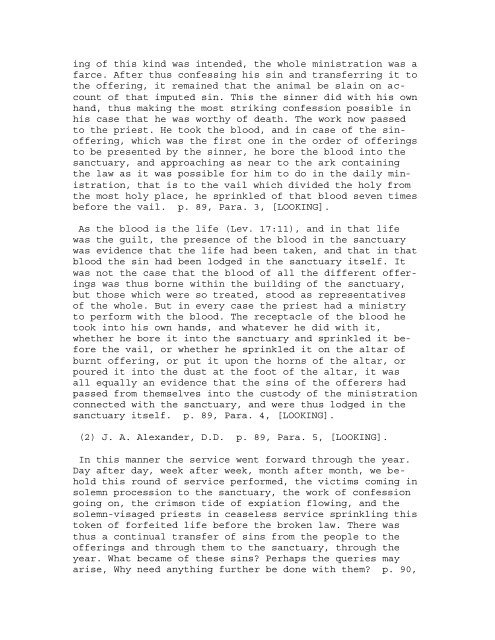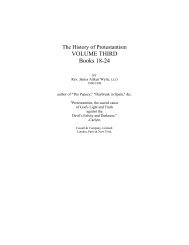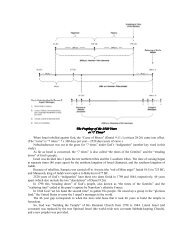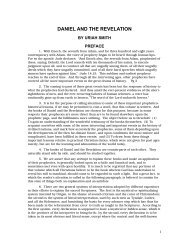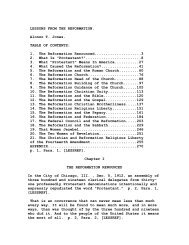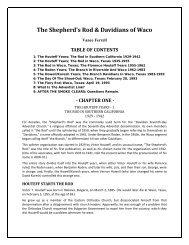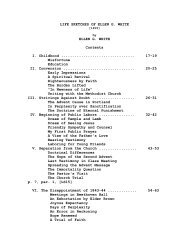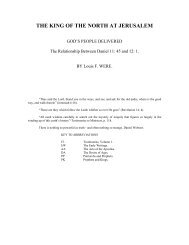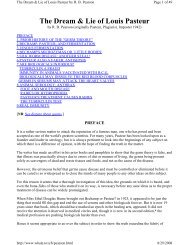LOOKING UNTO JESUS OR CHRIST IN TYPE AND ANTITYPE. BY ...
LOOKING UNTO JESUS OR CHRIST IN TYPE AND ANTITYPE. BY ...
LOOKING UNTO JESUS OR CHRIST IN TYPE AND ANTITYPE. BY ...
Create successful ePaper yourself
Turn your PDF publications into a flip-book with our unique Google optimized e-Paper software.
ing of this kind was intended, the whole ministration was a<br />
farce. After thus confessing his sin and transferring it to<br />
the offering, it remained that the animal be slain on account<br />
of that imputed sin. This the sinner did with his own<br />
hand, thus making the most striking confession possible in<br />
his case that he was worthy of death. The work now passed<br />
to the priest. He took the blood, and in case of the sinoffering,<br />
which was the first one in the order of offerings<br />
to be presented by the sinner, he bore the blood into the<br />
sanctuary, and approaching as near to the ark containing<br />
the law as it was possible for him to do in the daily ministration,<br />
that is to the vail which divided the holy from<br />
the most holy place, he sprinkled of that blood seven times<br />
before the vail. p. 89, Para. 3, [<strong>LOOK<strong>IN</strong>G</strong>].<br />
As the blood is the life (Lev. 17:11), and in that life<br />
was the guilt, the presence of the blood in the sanctuary<br />
was evidence that the life had been taken, and that in that<br />
blood the sin had been lodged in the sanctuary itself. It<br />
was not the case that the blood of all the different offerings<br />
was thus borne within the building of the sanctuary,<br />
but those which were so treated, stood as representatives<br />
of the whole. But in every case the priest had a ministry<br />
to perform with the blood. The receptacle of the blood he<br />
took into his own hands, and whatever he did with it,<br />
whether he bore it into the sanctuary and sprinkled it before<br />
the vail, or whether he sprinkled it on the altar of<br />
burnt offering, or put it upon the horns of the altar, or<br />
poured it into the dust at the foot of the altar, it was<br />
all equally an evidence that the sins of the offerers had<br />
passed from themselves into the custody of the ministration<br />
connected with the sanctuary, and were thus lodged in the<br />
sanctuary itself. p. 89, Para. 4, [<strong>LOOK<strong>IN</strong>G</strong>].<br />
(2) J. A. Alexander, D.D. p. 89, Para. 5, [<strong>LOOK<strong>IN</strong>G</strong>].<br />
In this manner the service went forward through the year.<br />
Day after day, week after week, month after month, we behold<br />
this round of service performed, the victims coming in<br />
solemn procession to the sanctuary, the work of confession<br />
going on, the crimson tide of expiation flowing, and the<br />
solemn-visaged priests in ceaseless service sprinkling this<br />
token of forfeited life before the broken law. There was<br />
thus a continual transfer of sins from the people to the<br />
offerings and through them to the sanctuary, through the<br />
year. What became of these sins? Perhaps the queries may<br />
arise, Why need anything further be done with them? p. 90,


